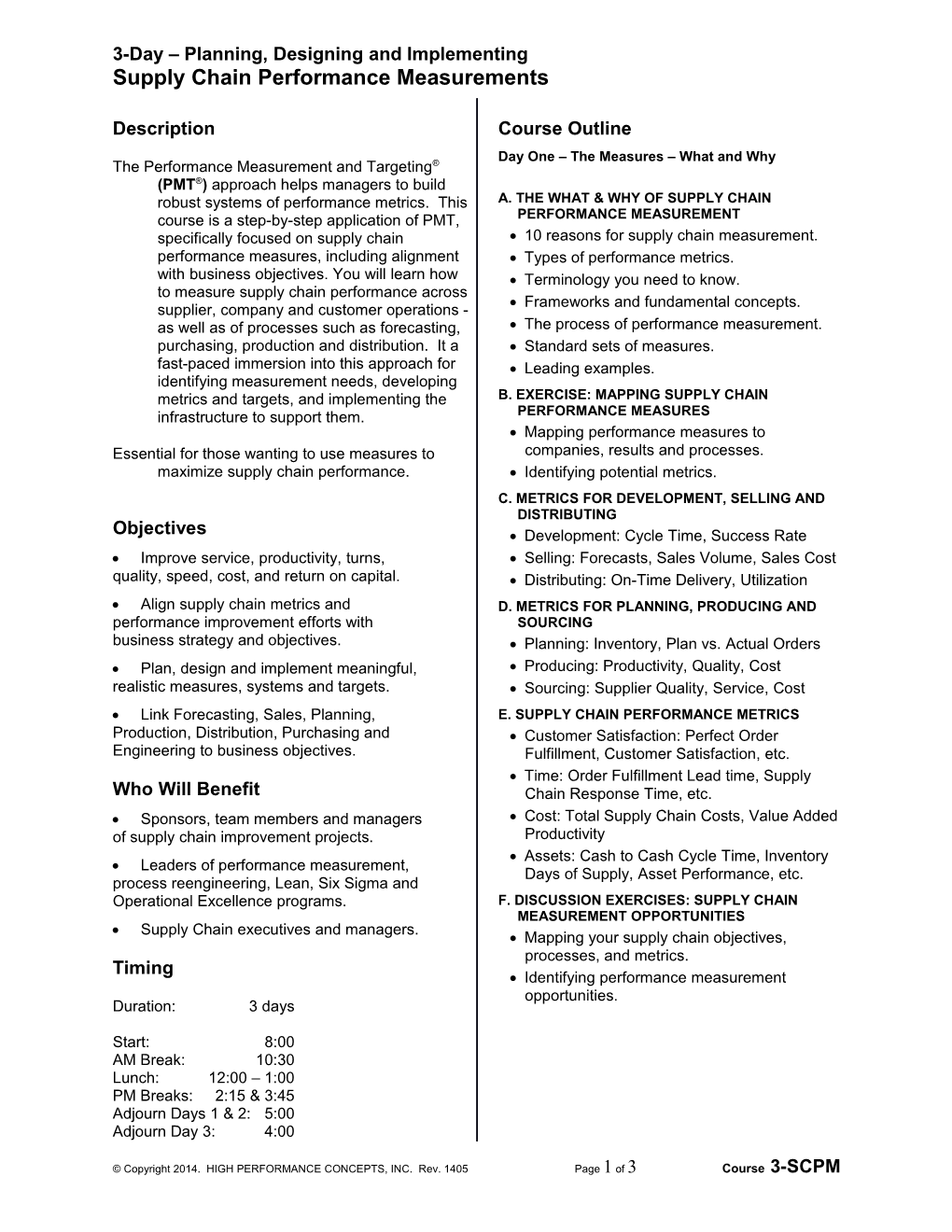3-Day – Planning, Designing and Implementing
Supply Chain Performance Measurements
DescriptionThe Performance Measurement and Targeting®(PMT®) approach helps managers to build robust systems of performance metrics. This course is a step-by-step application of PMT, specifically focused onsupply chain performance measures, including alignment with business objectives. You will learn how to measure supply chain performance across supplier, company and customer operations - as well as of processes such as forecasting, purchasing, production and distribution. It a fast-paced immersion into this approach for identifying measurement needs, developing metrics and targets, and implementing the infrastructure to support them.
Essential for those wanting to use measures to maximize supply chain performance.
Objectives- Improve service, productivity, turns, quality, speed, cost, and return on capital.
- Align supply chain metrics and performance improvement efforts with business strategy and objectives.
- Plan, design and implement meaningful, realistic measures, systems and targets.
- Link Forecasting, Sales, Planning, Production, Distribution, Purchasing and Engineering to business objectives.
Who Will Benefit
- Sponsors, team members and managers of supply chain improvement projects.
- Leaders of performance measurement, process reengineering, Lean, Six Sigma and Operational Excellence programs.
- Supply Chain executives and managers.
Duration:3 days
Start:8:00
AM Break:10:30
Lunch:12:00 – 1:00
PM Breaks:2:15 & 3:45
Adjourn Days 1 & 2:5:00
Adjourn Day 3:4:00 / Course Outline
Day One – The Measures – What and Why
A. THE WHAT & WHY OF SUPPLY CHAIN PERFORMANCE MEASUREMENT
- 10 reasons for supply chain measurement.
- Types of performance metrics.
- Terminology you need to know.
- Frameworks and fundamental concepts.
- The process of performance measurement.
- Standard sets of measures.
- Leading examples.
B. EXERCISE: MAPPING SUPPLY CHAIN PERFORMANCE MEASURES
- Mapping performance measures to companies, results and processes.
- Identifying potential metrics.
C. METRICS FOR DEVELOPMENT, SELLING AND DISTRIBUTING
- Development: Cycle Time, Success Rate
- Selling: Forecasts, Sales Volume, Sales Cost
- Distributing: On-Time Delivery, Utilization
D. METRICS FOR PLANNING, PRODUCING AND SOURCING
- Planning: Inventory, Plan vs. Actual Orders
- Producing: Productivity, Quality, Cost
- Sourcing: Supplier Quality, Service, Cost
E. SUPPLY CHAIN PERFORMANCE METRICS
- Customer Satisfaction: Perfect Order Fulfillment, Customer Satisfaction, etc.
- Time: Order Fulfillment Lead time, Supply Chain Response Time, etc.
- Cost: Total Supply Chain Costs, Value Added Productivity
- Assets: Cash to Cash Cycle Time, Inventory Days of Supply, Asset Performance, etc.
F. DISCUSSION EXERCISES: SUPPLY CHAIN MEASUREMENT OPPORTUNITIES
- Mapping your supply chain objectives, processes, and metrics.
- Identifying performance measurement opportunities.
3-Day – Planning, Designing and Implementing
Supply Chain Performance Measurements
Course Outline continuedDay Two – The Approach
A. THE PMT® APPROACH TO SUPPLY CHAIN PERFORMANCE MEASUREMENT
- The four phases of performance measurement planning and integration.
- The three fundamentals.
- Systematic planning procedures.
B. PERFORMANCE MEASUREMENT OPPORTUNITY ASSESSMENT & VISION
- Methodology for setting/weighting objectives and assessing opportunities.
- Linking metrics to process improvements and business objectives.
- How to agree on improvement priorities.
- CASE EXERCISE: Metrics Opportunity Assessment and Vision.
C. DEFINING PERFORMANCE MEASUREMENT OBJECTIVES & REQUIREMENTS
- Supporting improvement objectives with performance measures.
- Products and services to be measured, and processes and activities to be included.
- Timing requirements: frequency, shifts, etc.
- CASE EXERCISE: Defining performance measurement requirements.
D. SELECTING & DEFINING PERFORMANCE MEASURES & METHODS
- 7 criteria for performance metrics selection.
- How to select measures and methods.
- Who, What, When, Where, How, How Often
- CASE EXERCISE: Performance Metrics Selection and Definition.
E. REFINING & EVALUATING VIABLE ALTERNATIVES
- Validating and refining preliminary designs.
- Organizational and information limitations.
- Budget/economic constraints and other practical limitations and considerations.
- Non-financial and intangible factors.
- CASE EXERCISE: Evaluating alternative measurement proposals.
F. CREATING AN INTEGRATED PERFORMANCE MEASUREMENT SYSTEM
- Agreeing on a set of preliminary performance measures.
- Identifying integration needs.
- CASE EXERCISE: Preliminary performance measurement system.
Day Three – Design and Implementation
A. SETTING TARGETS: BASELINING, BRAINSTORMING & BENCHMARKING
- Setting realistic targets.
- Quantifying baselines and brainstorming for stretch objectives.
- Benchmarking of metrics and performance.
- Getting buy-in and putting it in writing.
- CASE EXERCISE: Setting Targets.
B. MEASUREMENT SYSTEM PLAN, JUSTIFICATION AND APPROVAL
- Costs & benefits for the projects and plan.
- Costs: Information systems, training, people.
- Tangible and intangible benefits.
- How to present the case to management.
- How to evaluate alternative measurement systems and plans.
- Sequencing measurement implementation.
- CASE EXERCISE: Planning Supply Chain Performance Measurement Improvements.
C. ROLE OF INFORMATION AND SYSTEMS
- Data collection, summarization and presentation. Routine and ad-hoc reporting.
- Need for a Performance Management Information System.
- Software / integration options: Data warehouses, report writers, packages.
- Build vs. buy.
- Locking SCPM with systems development.
- Leading-edge examples.
- Data standards and data collection.
D. DESIGNING METRICS AND METHODS
- Getting from concepts to detailed designs.
- The PMT procedures repeat.
- Guidelines for detailed design.
- Implementation planning.
- CASE EXERCISE: Detailed Design and Implementation Planning.
E. PLANNING AND MANAGING MEASUREMENT IMPLEMENTATIONS
- Obtaining organizational buy in.
- Project management – lessons learned.
- 10 common mistakes and metrics to avoid.
- How to create a sound implementation plan.
- CASE EXERCISE: Communications plan.
© Copyright 2014. HIGH PERFORMANCE CONCEPTS, INC. Rev. 1405Page 1 of 2Course 3-SCPM
